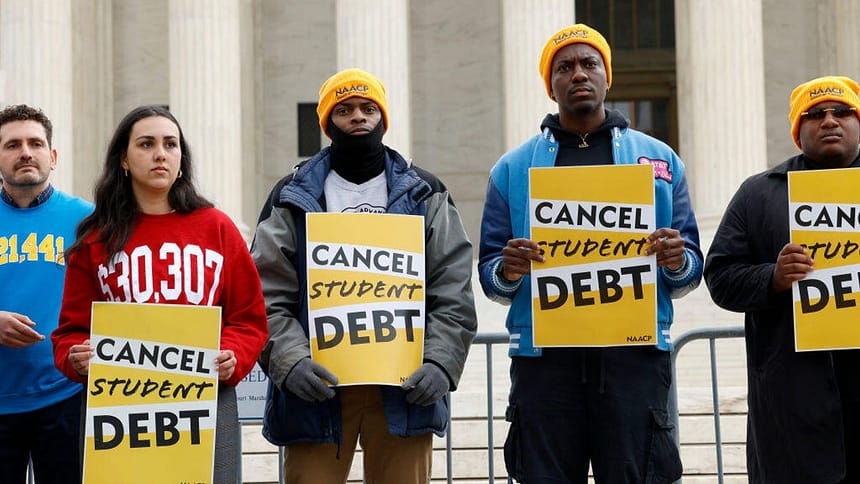
What’s going on with student loans? It’s a question that’s difficult to pin down when the answers seem to shift every week.
As a reporter who’s covered student loans since the beginning of the pandemic, and a borrower myself, it’s a topic I’m dialed in on, and even I’m finding it hard to keep track of all the changes.
News of wage garnishments, restarting payments for SAVE borrowers and even the decision to potentially move the student loan portfolio from the Department of Education to the Small Business Administration has left millions of borrowers confused. How will any of this work? What will payments look like for the nearly 8 million borrowers on SAVE? And when will teachers, nurses and other public servants who’ve satisfied the terms of the Public Service Loan Forgiveness program see loan discharges?
Reddit is awash with questions about what’s going on with student loans, with some users considering switching to a private lender for a potentially lower payment and some predictability after years of overwhelming pendulum swings. I spoke to a student loan expert, Edvisors Corporate Communications Director Elaine Rubin, to help answer some of your most pressing student loan questions.
What does the new student loan payment proposal mean for current borrowers?
Last week, Republicans put forth a new bill that would change the way student loan payments are calculated and repaid. The proposal hasn’t yet been approved by Congress, and it’s unclear whether any of the rules in this document will be finalized.
If the bill were to pass, borrowers with loans issued before July 1, 2026, wouldn’t see many changes, unless they’re enrolled in the income-contingent repayment plan. Borrowers on ICR would be moved to income-based repayment, and their monthly bill would be capped at 15% of their discretionary income.
Since SAVE is dead, should borrowers move to another IDR plan?
You may’ve heard that payments will be restarting soon for SAVE borrowers, which can be confusing, since your monthly payment will likely change. You can apply for another income-driven repayment plan if you’ve found one that’s a good fit, but Rubin said there’s no action you need to take right now.
Since it’s likely you’ll either be moved to another payment plan or given a window of time to select a new repayment plan, exploring other IDRs can help you calculate your new monthly payment. You can check out your repayment options using the student loan simulator at StudentAid.gov.
Are any changes happening to the Public Service Loan Forgiveness plan?
Teachers, nurses and other public servants enrolled in the Public Service Loan Forgiveness Plan have been on an even more tumultuous ride in the past few years. After President Joe Biden’s administration expanded PSLF to ensure more borrowers would receive forgiveness, the program was moved in-house to the Department of Education, causing a variety of delays.
Earlier this year, President Donald Trump announced some changes in eligibility for the PSLF, preventing anyone working for an organization deemed illegal from receiving forgiveness, but no official changes have been made to the program, according to StudentAid.gov.
Is debt relief through PSLF still being processed?
Some borrowers on Reddit have said they’ve met the forgiveness requirements but have yet to receive debt relief through either the PSLF or PSLF buyback program.
“We’ve heard there have been delays in processing,” Rubin said. “There are a lot of moving pieces in the background right now that are making it hard to estimate how quickly forgiveness will be granted.”
Whatever you do, Rubin warns not to stop making your monthly payments while you wait, as this could lead to other complications, such as wage garnishment while your forgiveness is being evaluated. Reach out to your loan servicer to figure out your best move while waiting for loan forgiveness, Rubin suggested. The servicer might be able to put your payments on hold or in forbearance in the meantime.
Any extra money you pay should be returned to you in the form of a refund after your forgiveness is processed.
Can you get approved for a lower student loan payment if your income has decreased?
If you’re on an income-driven repayment plan and your income has decreased, it can be helpful to recertify your income to see if your servicer will lower your monthly payment. Typically, the Department of Education requires borrowers to recertify their income annually. But this process has been on hold since the pandemic, with the expectation that it’ll resume in 2026.
To have your income recertified by the Department of Education, you’ll need to fill out an application at StudentAid.gov and select the option “recertify or change your income-driven repayment plan.”
It could take some time to process your application, Rubin noted. “Until the actual process completes and the new payment is approved, the borrower does have to make their required original monthly payments.”
If your income has increased, there’s no need to recertify until 2026.
Should I refinance my student loans with a private lender?
If you’re panicked about possible wage garnishment or worried about a higher monthly student loan payment, you might’ve been exploring other options, such as refinancing your student debt with a private lender. Though it rarely makes sense for borrowers to switch from federal to private student loans, Rubin acknowledged that this option could make sense, but only for a very specific borrower.
Rubin said borrowers like dentists or doctors, who earn higher incomes and wouldn’t qualify for any of the benefits of IDR plans or other federal student loan offers, might benefit from refinancing with a personal loan — in some cases. You’ll want to review your interest rate and any loan fees before making this decision.
For the large majority of borrowers, Rubin does not advise refinancing with a private student loan lender. You’ll be forfeiting your federal borrower protections, benefits and potential forgiveness options. And once you refinance your federal student debt with a private lender, you can’t ever move this debt back to the federal student loan program.
“It’s typically not recommended for borrowers who are relying or depending on an income-driven repayment plan,” said Rubin, “I especially don’t recommend it to anybody who’s living paycheck to paycheck. Even if you’re comfortably making payments, if something were to happen, you might find yourself locked into a very challenging situation.”
In addition, with many banks tightening their borrowing requirements, Rubin also said it could be an “extreme challenge” for borrowers to find a private student lender that would approve them for a refinancing loan. You’ll typically need a high credit score and low debt-to-income ratio to qualify for the best terms.
Instead of refinancing your debt with a private lender, Rubin said, borrowers should look into income-driven repayment plans, talk to their servicers about financial hardship, or consider loan consolidation if they qualify.
Is my student loan account being moved to collections?
On May 5, the Department of Education resumed efforts to begin collecting on defaulted student loan debt. If your loans are in default — meaning you’re 270 days or more past due on payments — expect them to be moved to a collections agency. Once your account is moved to collections, you’ll receive a letter from the Department of Education with steps to potentially get your loans out of default. If you do nothing, wage garnishment will begin in 30 days. Your wages could be garnished for up to 15% of your take-home pay.
To avoid having your paycheck docked, you can apply for loan rehabilitation, where you voluntarily re-enter repayment and after nine consecutive on-time payments, your loans get pulled out of default. You may also be able to apply for loan consolidation if you have multiple loans with varying interest rates. Consolidating your existing federal loans into a new direct loan could lower your interest rate and monthly payments, making it more affordable to repay your debt.
If you’re behind on payments but not yet in default, try reaching out to your servicer to work out a payment agreement. You should also check to see if you qualify for an income-driven repayment plan that could lower your monthly bill.






